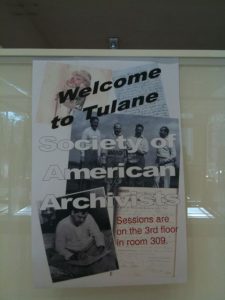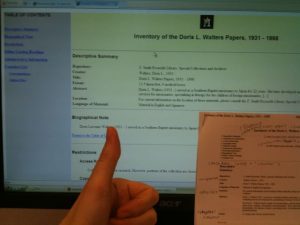This article is more than 5 years old.
Last Thursday and Friday, I participated in a workshop on Encoded Archival Description from the Society of American Archivists. Kris Kiesling from the University of Minnesota and Michael Fox from the Minnesota Historical Society are two of the founding developers of EAD and have been teaching this workshop for years.
After a thorough review of SGML/XML and the EAD standard, we practiced encoding a sample finding aid using the EAD tag library (which is available online) with the oXygen XML editor. We were able to ask lots of questions about the EAD DTD structure, including elements and their attributes. Because we use Archivists’ Toolkit at WFU, we can easily export EAD files (and MARC and container labels and more) instead of encoding them by hand or using a template.
Perhaps the most useful part of the workshop was our discussion of implementation issues for EAD, which included an exploration of publishing methods and stylesheets. In order for all of Special Collections and University Archives’ finding aids to appear online, we need a functional (and hopefully visually appealing) stylesheet. Right now we’re using one from the NC EAD working group and we’re working on making it work better with our EAD files. A stylesheet can make our finding aids more interactive, linked to other pages and digital objects, and show the finding aid in multiple formats (like PDF and printer-friendly).
Another cool thing: we talked about embedding digital objects into EAD, which I think is a great way to liven up text-driven finding aids. Maybe we can have a representative object/icon for each finding aid, and connect finding aids to our digital collections like ECU and other repositories are doing.
At the end of the day on Friday, we got the opportunity to encode one of our own finding aids. The workshop helped me gain a better idea of how to read and fix EAD, so we can put more finding aids out there!


6 Comments on ‘EAD Workshop in New Orleans’
Sounds like you are learning very useful stuff! From what I understand, our stylesheet-EAD connection can only get better!
You give me hope that EAD issues will soon be a thing of the past!
Excellent! I’m very glad they included discussions of implementation and D.O.s in the workshop.
Great pic 🙂 – Does AT include a mechanism for including links to DOs into EAD exports or will we need to find another way to add them?
Great question! Yes, it has a “Digital Objects” interface with options for connecting resources. We don’t have any connected…yet…
Hey, I was at that workshop! I actually work at Tulane’s Special Collections. Great post.